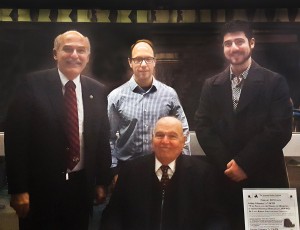
Photo: ASP Archive
Kara Statler
Staff Writer
Dr. Richard Hovannisian, Professor Emeritus of Armenian and Near Eastern at UCLA, was invited by the Armenian Studies Program at Fresno State to give a lecture entitled, “Armenian Communities of the Northeastern Mediterranean: Musa Dagh-Dört-Yol and Kessab,” on Friday, January 27 at the University Business Center at Fresno State. A standing room only audience enjoyed the moving lecture, co-sponsored by the Hamazkayin Educational and Cultural Association.
Dr. Hovannisian began a series of conferences in 1987 called the “Historic Armenian Cities and Provinces,” inviting scholars from throughout the world to participate. The conferences were often held twice a year and were intended to fill the gap between the first-generation survivors and their children and grandchildren. The young people could often not say where their ancestors had originated.
The conferences, which began with one on “Van,” originally covered the six major Armenian provinces of the Ottoman Turkish Empire. The papers given at each conference were eventually published in a series, culminating in the fourteenth volume on “The Armenian Communities of the Northeastern Mediterranean.”
Dr. Hovannisian expanded the scope of the conferences to cover other Ottoman Armenian communities, including a major conference on Constantinople. The last three volumes of the series were on Kesaria, the Armenian communities of Asia Minor.
Dr. Hovannisian showed a video presentation of his most recent trip to Musa Dagh. The video provided insight into contemporary Armenian life in Turkey, and gave information about the historic area of Musa Dagh and how it has changed. It also depicted Armenian churches that had been converted to mosques, as well as ruins of ancient Armenian fortresses.
The video concluded in Vakif, the only remaining Armenian village in Turkey, where 99 year-old Avedis Demirdjian resides. When asked what advice he had for young Armenians, Semirdjian said, “they should remember us. They should remember that there is this village in Musa Dagh; one village out of six where there are still Armenians.”
After the video, Dr. Hovannisian discussed the geography, the people, and the effects of the Genocide on Musa Dagh. Many of the residents of villages surrounding Musa Dagh decided to resist the deportation orders by fleeing to the mountain. Dr. Hovannisian described their month long resistance to the Turkish army and their miraculous rescue. Many of the survivors returned to Musa Dagh during the French Mandate of Syria. However, in 1938 the French made a deal with Turkish Nationalists and evacuated the region.
Dr. Hovannisian then described how the Armenians had to leave the region on short notice to avoid living under Turkish rule once again. While some moved to Fresno, many repatriated to Armenia where they continued to celebrate their traditions.
Dr. Hovannisian also dis-cussed Dört-Yol, a city in the province of Adana. He focused on the Hamidian Massacres of 1895-96 and the Adana massacre of 1909 by showing pictures from his travels to the region.
In conclusion, Dr. Hovanissian discussed Kessab, a town that is now in Syria and that faces a threat from recent incursions.
The residents of Kessab are fiercely loyal to their hometown and many of them would not leave when the threat of attacks in 2014 loomed over the town.
The night ended with questions from the audience and refreshments in the lobby.
 Hye Sharzhoom Armenian Action
Hye Sharzhoom Armenian Action